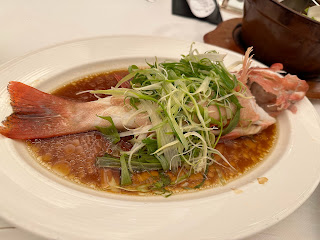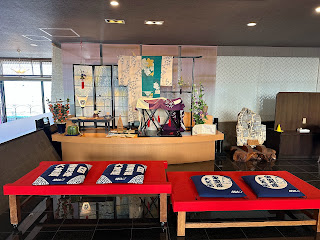This Japanese restaurant is located in The
Landmark Mandarin Oriental, just adjacent to Sushi Shikon. Led by Chef Masaru
Furukawa, it has been awarded Michelin one-star status in 2023. The word ‘kappo’
means ‘cut and cook’, highlighting this style of Japanese cuisine with the chef
cooking in front of customers and interact.
Dinner service has two periods, one
starting at 6pm and the other 8:30pm. We had reserved the earlier slot and were
seated at the end of the beautiful hinoki counter, which could accommodate 8
customers. The décor was nice, having an elegant and traditional ambience as if
one was in Japan.
The Dinner Menu cost $2,500 each and I also
ordered a bottle of sake:
東洋美人 純米大吟醸 プリンセスミチコ ($1,700). The yeast used in this
sake came from a rose variety known as ‘Princess Michiko’, which was presented
from England when the current Empress was the crown princess. It had an elegant
nose with a nice sweetness, good pairing with the food on the night.
The first course already drew a gasp of
wonder when it was presented. On a fresh green lotus leaf was an orange lantern
flower, or Alkekengi. Opening inside was a piece of nicely grilled
Eel,
with crispy skin and great umami flavours of the unagi sauce, and with a bit of
wasabi and sancho leaves to add a hint of spicy notes. Underneath was some
shredded
Cucumber with a crunchy texture to contrast, and also helped to
freshen the palate. A wonderful appetizer.
The second course featured
Straw Smoked
Bonito, with the chef marinated the skipjack tuna in soy sauce briefly,
giving it an extra layer of savoury flavour, which also brought forward the
umami taste, in addition to the fragrant straw smoky note. Everything was so
balanced and harmonized. Instead of having wasabi, it was paired with seaweed paste which got
radish mixed in. Truly delicious sashimi.
The third course showcased how the chef
paid attention to all details. While the chef prepared the dashi in front of
us, the sous chef poured hot water to heat up the serving bowl. When everything
was ready, the
Hairy Crab Dumpling was taken out from the steamer to the
bowl, together with
Abalone and
Green Yuzu. Pouring the dashi in
and then covered with lid, the sous chef sprayed some clean water on the bowl,
as a tradition to show that the bowl had not been opened or tampered. The hot clear
soup was amazing in taste, with the crab meat dumpling sweet and delicate. The
abalone offered a good bite, but I did not think it was truly necessary to add
that given the dish was so good already. Amazing soup.
Originally in the menu the fourth course featured
Taichio, but since there were some incredible
Kinmedai available the
chef decided to use them instead. He also perfectly grilled the
Matsutake
Mushroom on hibachi, cooking through but not drying. These prized matsutake
was called ‘early matsu’ as they were harvested before the normal season. Paired
with Sudachi Lime to give some refreshing acidity, the radish and yam paste together
with yuzu shavings helped to complement the flavours. A wonderful grilled dish.
The fifth course was
Seasonal Sushi.
The chef toasted the nori sheet on hibachi to make them crisp, and then put the
shari, abundance of minced maguro with takuan, and Bafun-uni in to make the
sushi. The rich and fantastic flavours from the fish oil of the tuna, the umami
taste of the sea urchin, the creamy and soft texture of both contrasting with
the crunchy bite of takuan, all wrapping up in the crisp nori, created a
symphony of taste and texture. I had to resist the temptation to immediately
ask for an encore of this sushi.
The sixth course showcased the tempura
technique, with the chef cutting the
Swordtip Squid in thin strips and
put inside the bowl, on top was deep-fried
Aoyagi Clam in a seaweed
batter, with also
Ginger and
Okra. The batter was very thin and virtually
non-existent. Mixing everything together was a feast, allowing us to enjoy
different texture and flavours at the same time. Very good fried dish.
The seventh course again brought a wow to
all of us, a cocktail glass with a bubble containing white fumes inside. Using the
spoon to poke the bubble, the tomato water got
Sea Urchin,
Whelk,
Mozuku Sea Moss,
Water Shield,
Spaghetti Squash, and
Japanese Cantaloupe Melon. Refreshing and serving as a palate cleanser, the
different ingredients offered contrasts in texture to make this dish
interesting, with the delicate taste harmonized and not over-shadowing each other in flavours. Thoughtful and a creative refreshment deviating from traditional Japanese
cuisine.
The eighth course featured
Matsusaka
Wagyu Beef Sukiyaki, with
Onion and
Crown Daisy. The beef was
flavourful and great in taste, and again the attention in steaming the plate beforehand
to keep it warm on serving, the half-poached egg with runny yolk to add to the
sukiyaki sauce, and the careful timing of blanching the crown daisy to avoid
over-cooking the delicate vegetable, were all meticulous. I also liked the
onion which added a sweetness to the dish. Very delicious seasonal course.
The ninth course was kamameshi, with the
rice cooked in clay pot, then added a large amount of spring onion, and then grilled
Tile Fish on top. Together with
Pickles and
Miso Soup,
the rice was really fantastic, not too soft nor too hard, fragrant with the
spring onion, and the seasoning of tile fish was also spot on. Both of us ended
up having three servings as it was so good. While the other diners might feel
we were too hungry, we were not shy to ask for more of this really
delicious rice.
I was puzzled earlier when seeing the ice
shaving equipment at the counter, but then the chef brought out a slab
of natural ice and then laboriously turning the wheel to shave off the ice,
making our tenth course of
Summer Limited Shaved Ice. The texture was
very powdery, ethereal, and dissolving in the mouth in no time which reminded
me of soft snow. There were layers of red beans, matcha, milk, sake foam and a
sour plum to add colours and flavours to the shaved ice. It totally revolutionized
my perception of this type of dessert. Must try if you got the chance!
The eleventh and last course was
Amazake with
Grilled
Mochi. The amazake was a traditional sweet low-alcohol beverage made from
fermented rice. Serving it hot, with a piece of grilled mochi having chewy bite, this
in my opinion was a much better dessert than the typical slice of melon, grapes
or strawberries. The effort and how the chef was able to balance the earlier
shaved ice using this wagashi to warm our stomach was thoughtful.
Service was very good, with the staff
friendly and attentive, able to introduce the cuisine to us in details. The bill
on the night was $7,370 and while it was not cheap, I would certainly like to
come back again, especially knowing that the chef would regularly change
the menu to match with the season and highlight the best ingredients at the
time.






















































